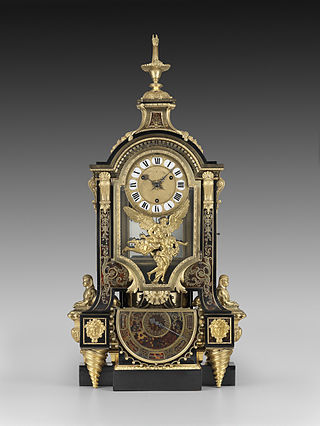Top Qs
Timeline
Chat
Perspective
Barometer Clock
17th century clock by André-Charles Boulle From Wikipedia, the free encyclopedia
Remove ads
Barometer Clock (Boulle) by André-Charles Boulle is a late seventeenth-century French clock created out of ebony, turtle shell, brass, gilt bronze, and enamel. The clock case is decorated on all sides and was intended as either a centerpiece or for display on a mantel in front of a mirror.[1] The centerpiece of the clock is a relief of "Father Time unveiling Truth."[2]
This late seventeenth-century clock also functions as a barometer; the "two doors on the rear of the clock open to reveal a glass tube containing mercury and a float to which thread is attached."[1] The semicircular barometer dial indicates five weather conditions from one extreme, beaucoup de pluye (rainy), to the other, beau fixe (fine).[3]
Boulle, who gave his name to the type of veneering on this clock, is listed in the French Archives Nationales as a cabinet maker, maker of marquetry, and gilder and chaser of bronzes. [2]
The clock movement design is by either Isaac Thuret or his son Jacques Thuret. The dial and backplate of the movement are both signed "I. Thuret...", the character I and J being interchangeable during the period.[2]

Remove ads
Acquisition
The Barometer Clock was acquired by The Frick Collection through the bequest of New York collector Winthrop Kellogg Edey in 1999. Edey's bequest included twenty-five clocks and fourteen watches as well as his library and archives.[4]
Exhibition
- "Magnificent Timekeepers: An Exhibition of Northern European Clocks in New York Collections,” 1972, Metropolitan Museum of Art.
- "French Clocks in North American Collections," November 2, 1982 - January 30, 1983, The Frick Collection.
- "The Art of the Timekeeper: Masterpieces from the Winthrop Edey Bequest," November 14, 2001 - February 24, 2002, The Frick Collection.
See also
References
External links
Wikiwand - on
Seamless Wikipedia browsing. On steroids.
Remove ads

